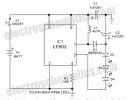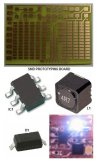Here is an interesting circuit of a true-portable and cute solid-state bright light built with LT1932. The light can be operated from two AA size dry/rechargeable pen-light cells.
There is no housing included so that you can use your own imagination as to what you would like to do with this light circuit. A search light, cupboard light, pathway light or an inspection head light!
The LED Bright Light circuit is realised using a small 6 pin integrated circuit in SMD package LT1932 (IC1) from Linear Technologies. The LT1932 is a fixed frequency step-up DC to DC converter designed to operate as a constant-current source.
Because it directly regulates output current, the LT1932 is ideal for driving light emitting diodes (LEDs) whose light intensity is proportional to the current passing through them, not the voltage across their terminals.
The LT1932 accurately regulates LED current even when the input voltage is higher than the LED voltage, greatly simplifying battery powered designs. A single external resistor sets LED current between 5mA and 40mA. In this circuit the LED current is set to 15mA with R1=1.5Kilo Ohm. Here IC1 is configured as a two cell driver for three white LEDs(D2-D4). This design strictly follows the LT application data of LT1932.
Portable High LED Light Circuit Schematic

A small SMD prototyping board may be used for construction of the whole circuit.As with all switching regulators, careful attention must be paid to the PCB board layout and SMD component placement.To prevent radiation and high frequency resonance problems, proper layout of the high frequency switching path is essential. Minimize the length and area of all traces connected to pin 1, and always use a ground plane under the switching regulator to minimize interplane coupling.

The signal path including pin 1, output diode D1 and output capacitor C2, contains nanosecond rise and fall times and should be kept as short as possible. In addition, the ground connection for the resistor R1 should be tied directly to pin 2 and not be shared with any other component, ensuring a clean, noise-free connection.
Low ESR (equivalent series resistance) capacitor should be used as C2 to minimize the output ripple voltage. Similarly, D1 must be a Schottky diode, with low forward voltage drop and fast switching speed. Make sure that the diode has a voltage rating greater than the output voltage.
MBR0540 (500mA/40V) is a good selection for D1. The value and type of the power inductor (L1) also plays an important role in the overall system efficiency. As core losses at 1.2MHz are much lower for ferrite cores than for the cheaper powdered-iron ones, ferrite core inductor should be used to obtain the best efficiency. Choose a 4.7 micro-henry inductor that can handle at least 500mA.
There is no housing included so that you can use your own imagination as to what you would like to do with this light circuit. A search light, cupboard light, pathway light or an inspection head light!
The LED Bright Light circuit is realised using a small 6 pin integrated circuit in SMD package LT1932 (IC1) from Linear Technologies. The LT1932 is a fixed frequency step-up DC to DC converter designed to operate as a constant-current source.
Because it directly regulates output current, the LT1932 is ideal for driving light emitting diodes (LEDs) whose light intensity is proportional to the current passing through them, not the voltage across their terminals.
The LT1932 accurately regulates LED current even when the input voltage is higher than the LED voltage, greatly simplifying battery powered designs. A single external resistor sets LED current between 5mA and 40mA. In this circuit the LED current is set to 15mA with R1=1.5Kilo Ohm. Here IC1 is configured as a two cell driver for three white LEDs(D2-D4). This design strictly follows the LT application data of LT1932.
Portable High LED Light Circuit Schematic

A small SMD prototyping board may be used for construction of the whole circuit.As with all switching regulators, careful attention must be paid to the PCB board layout and SMD component placement.To prevent radiation and high frequency resonance problems, proper layout of the high frequency switching path is essential. Minimize the length and area of all traces connected to pin 1, and always use a ground plane under the switching regulator to minimize interplane coupling.

The signal path including pin 1, output diode D1 and output capacitor C2, contains nanosecond rise and fall times and should be kept as short as possible. In addition, the ground connection for the resistor R1 should be tied directly to pin 2 and not be shared with any other component, ensuring a clean, noise-free connection.
Low ESR (equivalent series resistance) capacitor should be used as C2 to minimize the output ripple voltage. Similarly, D1 must be a Schottky diode, with low forward voltage drop and fast switching speed. Make sure that the diode has a voltage rating greater than the output voltage.
MBR0540 (500mA/40V) is a good selection for D1. The value and type of the power inductor (L1) also plays an important role in the overall system efficiency. As core losses at 1.2MHz are much lower for ferrite cores than for the cheaper powdered-iron ones, ferrite core inductor should be used to obtain the best efficiency. Choose a 4.7 micro-henry inductor that can handle at least 500mA.
Eklentiler
Son düzenleme:
